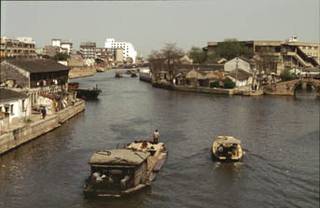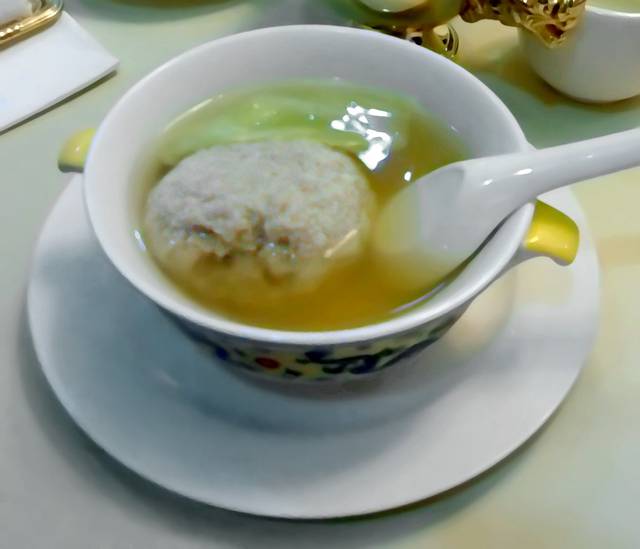
Zhenjiang is a city in Jiangsu province, located just across the Yangtze River from Yangzhou. Zhenjiang is a historic city and visitors come to see its collection of preserved medieval buildings as well as newer English-style houses.

Zhenjiang is a historically important city of Jiangsu province. It was long an important entrepôt at the intersection of the Grand Canal and the Yangtze River near its mouth, and has some medieval historic buildings. One of these is Jinshan Temple, with a spectacular setting on a mountain overlooking the water, which is known to most people in China as the setting of a famous legend, about a snake-spirit that falls in love with a man. In the 19th century, Zhenjiang became a "treaty port" open to international trade, and a British concession was established here. Some of the English-style houses and public buildings from the British period still survive, including the home of writer Pearl Buck. The ferry crossing at Zhenjiang was an important crossing on the lower Yangtze. A range of ancient poets crossed here and wrote poems to record their experiences; Marco Polo also mentions crossing the Yangtze here. Today, it is a preserved quarter with an ecletic mixture of medieval Chinese temples and 19th century European-style buildings built by the British. From 1928 to 1949, Zhenjiang served as the capital of Jiangsu province, and there are some elegant houses from this period which are preserved along Boxian Road. Like nearby Yangzhou, Zhenjiang is also famous for its refined cuisine.
Four major parks in Zhenjiang provide the most common destinations to tourists. Entrance to each park is ¥30-50, and the parks with pagodas charge another entrance fee if you wish to climb the pagoda. The parks are all nice, but if you are not interested in Chinese history, legends and architecture and view them only as parks, then if you've seen one "park" in the city, you've seen them all. If considered purely as places to relax, Jiaoshan is enjoyable if you want to get away from people (it's nearly empty all the time), and Jinshan is nice if you want to boat around the lake (paddle and electric boats are available). Nanshan is currently being renovated (early 2008) and will hopefully be greatly improved. All parks have legendary history, which is the main reason they attract visitors. Jinshan Park is famous for being a "mountain encompassed by monasteries (寺裹山)". It is the setting of the ancient legend and novel "Tale of the White Snake (白蛇传)", in which it is flooded by the heroine, a white snake spirit, because the abbot of the Buddhist monastery had imprisoned her husband. Beigushan Park, near the Yangtze river, was a legendary stronghold in ancient times. During the Three Kingdoms period, the rulers of two of the kingdoms, Liu Bei and Sun Quan, took a horse ride here together to discuss forming an alliance - which ultimately changed China history forever. Jiaoshan Park, on an island, is famous for having "monasteries encompassed by mountains (山裹寺)" and is connected to the history of local resistance to a British invasion in the 19th century. Some iron cannons from the historical fortifications can still be found here.
- Jiaoshan Park. Located on a small island in the Yangtze River and includes a large pagoda, peacock farm, and many winding paths through dense foliage. Bamboo forests partially cover the island.
- Jinshan Park. Located on the Northwest side of Zhenjiang and includes a Buddhist monastery and another large pagoda. The Buddhist temple complex and a large lake (complete with paddle boats available for rent) form the majority of the park.
- Beigushan Park. Located on the North side of Zhenjiang and has paths lit with lanterns after sundown. The park is surrounded by great landscaping and the Yangtze River.
- Nanshan Park. Located on the South side of Zhenjiang. It includes a hill with various paths snaking up and down it. A large pagoda at the top of the hill offers great views of the city, the river, and the surrounding countryside. The climb is very easy and takes less than an hour. Many people barbecue at small pits next to a lake to the East of the park entrance.
- Xijindu Ancient Street, foothills of Yuntai Mountain, Jingkou District (Bus #2 from DaShiKou (downtown, in front of Pizza Hut). An ancient ferry crossing - heavily modified by contemporary restoration to create a more "ancient" feel. There are some interesting preserved medieval buildings and various shops and restaurants targeting tourists.
- Zhulin Si. The "Bamboo Forest Temple" located in a valley between two mountains. The valley is located near Zhaoyin Mountain, which due to the profusion of mountain bamboo is also known as Bamboo Hill. The temple is so-named because it is surrounded by bamboo forest, and from afar it cannot be seen amongst the bamboo.

Zhenjiang is known for producing the best vinegar in China. Most major cities situated nearby provide Zhenjiang vinegar whenever dumplings are served. Steamed dumplings with the famous vinegar can be found on almost every block in town. Zhenjiang and nearby Yangzhou are the centres of "Zhen-Yang cuisine", one of the major traditions of Chinese cuisine which is prized across China and known for its subtle and light flavours, refined techniques and the emphasis of fresh vegetable and freshwater fish, crustaceans and shellfish, including in particular freshwater crabs, prawns and fish. Like most Chinese cities, Zhenjiang also houses a variety of restaurants serving dishes from each of the four main culinary traditions in China. More exotic food includes Japanese, Korean, and Russian cuisine. A Brazilian barbecue can even be found near the city center. Western fast food restaurants in Zhenjiang include McDonalds, KFC, and a Pizza Hut.
- 1880. 9-3. A typical Chinese bar, with entertainers and live music. ¥50 for cocktails, bottle service starts at ¥400.

